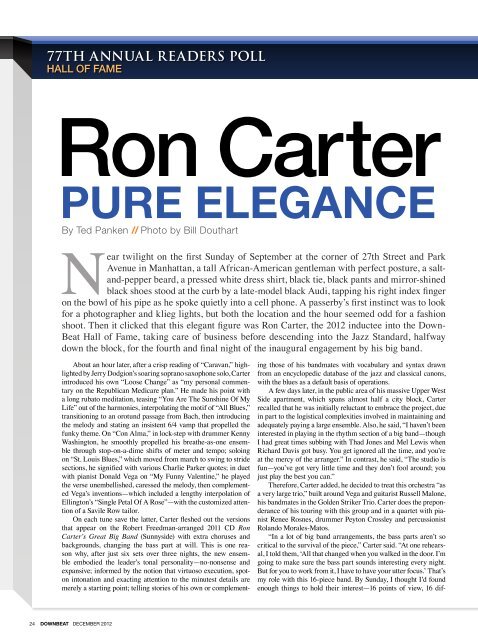Ron Carter Esperanza Spalding - Downbeat
Ron Carter Esperanza Spalding - Downbeat
Ron Carter Esperanza Spalding - Downbeat
You also want an ePaper? Increase the reach of your titles
YUMPU automatically turns print PDFs into web optimized ePapers that Google loves.
77th Annual readers Poll<br />
Hall of fame<br />
<strong>Ron</strong> <strong>Carter</strong><br />
Pure Elegance<br />
By Ted Panken // Photo by Bill Douthart<br />
Near twilight on the first Sunday of September at the corner of 27th Street and Park<br />
Avenue in Manhattan, a tall African-American gentleman with perfect posture, a saltand-pepper<br />
beard, a pressed white dress shirt, black tie, black pants and mirror-shined<br />
black shoes stood at the curb by a late-model black Audi, tapping his right index finger<br />
on the bowl of his pipe as he spoke quietly into a cell phone. A passerby’s first instinct was to look<br />
for a photographer and klieg lights, but both the location and the hour seemed odd for a fashion<br />
shoot. Then it clicked that this elegant figure was <strong>Ron</strong> <strong>Carter</strong>, the 2012 inductee into the Down-<br />
Beat Hall of Fame, taking care of business before descending into the Jazz Standard, halfway<br />
down the block, for the fourth and final night of the inaugural engagement by his big band.<br />
About an hour later, after a crisp reading of “Caravan,” highlighted<br />
by Jerry Dodgion’s soaring soprano saxophone solo, <strong>Carter</strong><br />
introduced his own “Loose Change” as “my personal commentary<br />
on the Republican Medicare plan.” He made his point with<br />
a long rubato meditation, teasing “You Are The Sunshine Of My<br />
Life” out of the harmonies, interpolating the motif of “All Blues,”<br />
transitioning to an orotund passage from Bach, then introducing<br />
the melody and stating an insistent 6/4 vamp that propelled the<br />
funky theme. On “Con Alma,” in lock-step with drummer Kenny<br />
Washington, he smoothly propelled his breathe-as-one ensemble<br />
through stop-on-a-dime shifts of meter and tempo; soloing<br />
on “St. Louis Blues,” which moved from march to swing to stride<br />
sections, he signified with various Charlie Parker quotes; in duet<br />
with pianist Donald Vega on “My Funny Valentine,” he played<br />
the verse unembellished, caressed the melody, then complemented<br />
Vega’s inventions—which included a lengthy interpolation of<br />
Ellington’s “Single Petal Of A Rose”—with the customized attention<br />
of a Savile Row tailor.<br />
On each tune save the latter, <strong>Carter</strong> fleshed out the versions<br />
that appear on the Robert Freedman-arranged 2011 CD <strong>Ron</strong><br />
<strong>Carter</strong>’s Great Big Band (Sunnyside) with extra choruses and<br />
backgrounds, changing the bass part at will. This is one reason<br />
why, after just six sets over three nights, the new ensemble<br />
embodied the leader’s tonal personality—no-nonsense and<br />
expansive; informed by the notion that virtuoso execution, spoton<br />
intonation and exacting attention to the minutest details are<br />
merely a starting point; telling stories of his own or complementing<br />
those of his bandmates with vocabulary and syntax drawn<br />
from an encyclopedic database of the jazz and classical canons,<br />
with the blues as a default basis of operations.<br />
A few days later, in the public area of his massive Upper West<br />
Side apartment, which spans almost half a city block, <strong>Carter</strong><br />
recalled that he was initially reluctant to embrace the project, due<br />
in part to the logistical complexities involved in maintaining and<br />
adequately paying a large ensemble. Also, he said, “I haven’t been<br />
interested in playing in the rhythm section of a big band—though<br />
I had great times subbing with Thad Jones and Mel Lewis when<br />
Richard Davis got busy. You get ignored all the time, and you’re<br />
at the mercy of the arranger.” In contrast, he said, “The studio is<br />
fun—you’ve got very little time and they don’t fool around; you<br />
just play the best you can.”<br />
Therefore, <strong>Carter</strong> added, he decided to treat this orchestra “as<br />
a very large trio,” built around Vega and guitarist Russell Malone,<br />
his bandmates in the Golden Striker Trio. <strong>Carter</strong> does the preponderance<br />
of his touring with this group and in a quartet with pianist<br />
Renee Rosnes, drummer Peyton Crossley and percussionist<br />
Rolando Morales-Matos.<br />
“In a lot of big band arrangements, the bass parts aren’t so<br />
critical to the survival of the piece,” <strong>Carter</strong> said. “At one rehearsal,<br />
I told them, ‘All that changed when you walked in the door. I’m<br />
going to make sure the bass part sounds interesting every night.<br />
But for you to work from it, I have to have your utter focus.’ That’s<br />
my role with this 16-piece band. By Sunday, I thought I’d found<br />
enough things to hold their interest—16 points of view, 16 dif-<br />
24 DOWNBEAT DECEMBER 2012
















